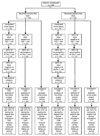Longer term efficacy of a prophylactic monovalent human papillomavirus type 16 vaccine
- PMID: 19647066
- PMCID: PMC2749988
- DOI: 10.1016/j.vaccine.2009.07.027
Longer term efficacy of a prophylactic monovalent human papillomavirus type 16 vaccine
Abstract
We conducted an extended follow-up study (March 2006-May 2008) to assess the longer term efficacy of a prophylactic monovalent human papillomavirus (HPV) type 16 L1 virus-like particle vaccine in women (n=290) who had enrolled in a randomized controlled trial of this vaccine (October 1998-November 1999) in Seattle and remained HPV-16 DNA negative during the course of that trial. During the extended follow-up period, in the per-protocol susceptible population, none of the vaccine recipients was found to be infected with HPV-16 or developed HPV-16-related cervical lesions; among placebo recipients, 6 women were found to be infected with HPV-16 (vaccine efficacy [VE]=100%; 95% confidence interval [CI]: 29-100%) and 3 women developed HPV-16-related cervical lesions (VE=100%; 95% CI: <0-100%). Approximately 86% of vaccine recipients remained HPV-16 competitive Luminex immunoassay seropositive at an average of 8.5 years of follow-up. During the combined original trial and extended follow-up period, in the intention-to-treat population, 20 and 22 women developed any cervical lesion regardless of HPV type among the vaccine and placebo recipients, respectively (VE=15%; 95% CI: <0-56%). The results suggest that this monovalent HPV-16 vaccine remains efficacious through 8.5 years after its administration.
Conflict of interest statement
The University of Washington has received funding from Merck to support HPV vaccine research conducted by CM and LAK. FBA and JTB are employees of Merck.
Figures


References
-
- Bosch FX, de Sanjose S. Chapter 1: Human papillomavirus and cervical cancer--burden and assessment of causality. J Natl Cancer Inst Monogr. 2003;31:3–13. - PubMed
-
- Walboomers JM, Jacobs MV, Manos MM, Bosch FX, Kummer JA, Shah KV, et al. Human papillomavirus is a necessary cause of invasive cervical cancer worldwide. J Pathol. 1999;189(1):12–19. - PubMed
-
- Koutsky LA, Harper DM. Chapter 13: Current findings from prophylactic HPV vaccine trials. Vaccine. 2006;24 Suppl 3:S3/114–S3/121. - PubMed
-
- La Torre G, de Waure C, Chiaradia G, Mannocci A, Ricciardi W. HPV vaccine efficacy in preventing persistent cervical HPV infection: a systematic review and meta-analysis. Vaccine. 2007;25(50):8352–8358. - PubMed

